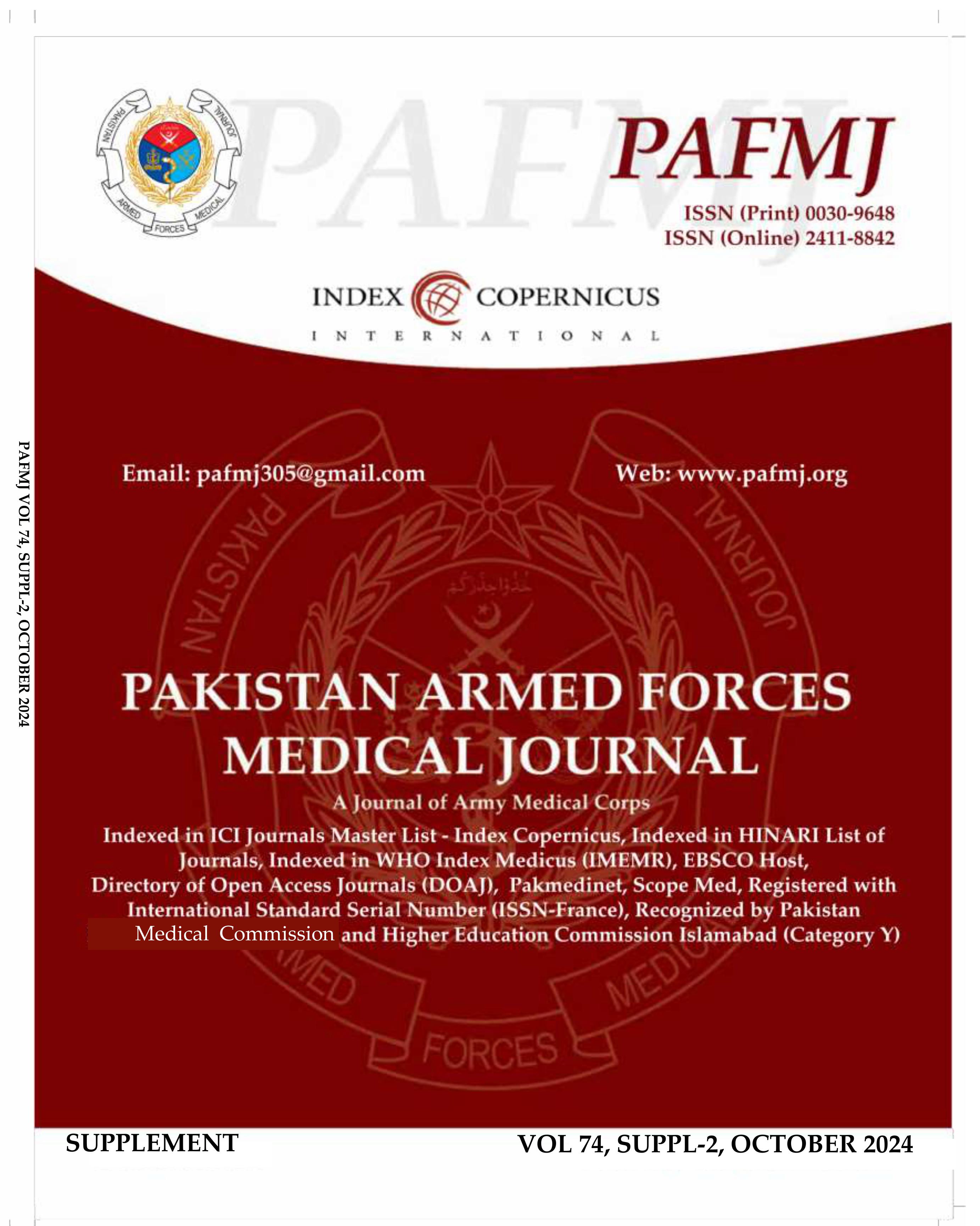Functional Outcome and Complications Following PHILOS Plate Fixation inProximal Humeral Fractures
DOI:
https://doi.org/10.51253/pafmj.v74iSUPPL-2.10439Keywords:
Interlocking system, locking plate, Proximal humeral fracture, PHILOS.Abstract
Objective: The purpose of this study is to assess the functional outcome following plate fixation with the Proximal Humeral
Internal Locking System and to study complications associated with it.
Study design: Prospective longitudinal study.
Place and duration of study: Department of Orthopedic Surgery, Combined Military Hospital, Rawalpindi Pakistan, for 14
months from 01 Sep 2021 – 31 Oct 2022.
Methodology: A total of 75 patients participated in this study. Patients included in the study were aged 18 years or above with
displaced proximal Humeral fractures. Patients were selected from in-patient department. They were explained the purpose of
the study and those who consented to participate in the study were enrolled through a written consent form. Proximal
Humeral Interlocking system was applied under general anesthesia. Follow up at 01 months, 03 months and 06 months was
carried out for functional outcome & complications if any.
Results: A total of 75 patients were registered in this study. Average age of cohort was 42.05±15.83 years with 46 males and 29
females. At 06 months the mean Constant score of the cohort was 58.96±6.44 and mean ASES score was 60.15±8.08. Most
common complication seen was superficial wound site infection with a frequency of 6(8%) that was resolved with dressing.
Conclusion: Functional outcome of Proximal Humeral Fractures managed with Interlocking system is very effective, though it
declines with age.
Early mobilization of shoulder joint is achievable without compromising union of fracture segments.
Downloads
References
Seebeck J, Goldhahn J, Städele H, Messmer P, Morlock MM,
Schneider E, et al. Effect of cortical thickness and cancellous
bone density on the holding strength of internal fixator screws. J
Orthop Res 2004; 22: 1237-42.
https://doi.org/10.1016/j.orthres.2004.04.001
Saber AY, Said UN, Abdelmonem AH. Surgical Fixation of
Three- and Four-Part Proximal Humeral Fractures Using the
Proximal Humeral Interlocking System Plate. Cureus 2022; 14(5):
e25348. Published 2022 May 26.
https://doi.org/10.7759/cureus.25348
Canale ST, Azar FM, Beaty JH. Open reduction and internal
fixation of proximal humeral fractures with use of the locking
proximal humerus plate. Results of a prospective, multicenter,
observational study. Campbell’s Operative Orthopaedics.
Elsevier; 2017.
Südkamp N, Bayer J, Hepp P. Constant-Murley Score:
systematic review and standardized evaluation in different
shoulder pathologies. J Bone Joint Surg Am 2009; 91: 1320–1328.
Vrotsou K, Ávila M, Machón M, Mateo-Abad M, Pardo Y, Garin
O et al. Constant-Murley Score: systematic review and
standardized evaluation in different shoulder pathologies. Qual
Life Res 2018; 27(9): 2217-2226.
https://doi.org/10.1007/s11136-018-1875-7
Jabran A, Peach C, Ren L. Biomechanical analysis of plate
systems for proximal humerus fractures: a systematic literature
review. Biomed Eng Online 2018; 17(1): 47. Published 2018 Apr
https://doi.org/10.1186/s12938-018-0479-3
Windolf M, Knierzinger D, Nijs S. In Vitro Testing and Clinical
Handling of a Novel Implant Positioning Technology for
Proximal Humeral Plating. Medicina (Kaunas) 2023; 59(3): 450.
https://doi.org/10.3390/medicina59030450
Laux CJ, Grubhofer F, Werner CML, Simmen HP, Osterhoff G.
Current concepts in locking plate fixation of proximal humerus
fractures. J Orthop Surg Res 2017; 12(1): 137.
https://doi.org/10.1186/s13018-017-0639-3
Plath JE, Kerschbaum C, Seebauer T. Locking nail versus locking
plate for proximal humeral fracture fixation in an elderly
population: a prospective randomised controlled trial. BMC
Musculoskelet Disord 2019; 20(1): 20.
https://doi.org/10.1186/s12891-019-2399-1
Vidović D, Benčić I, Cuti T. Treatment of humeral shaft
fractures: antegrade interlocking intramedullary nailing with
additional interlocking neutralization screws through fracture
site. Acta Clin Croat 2019; 58(4): 632-638.
https://doi.org/10.20471/acc.2019.58.04.10
Jabran A, Peach C, Ren L. Biomechanical analysis of plate
systems for proximal humerus fractures: a systematic literature
review. Biomed Eng Online 2018; 17(1): 47.
https://doi.org/10.1186/s12938-018-0479-3
Shi X, Liu H, Xing R. Effect of intramedullary nail and locking
plate in the treatment of proximal humerus fracture: an update
systematic review and meta-analysis. J Orthop Surg Res 2019;
(1): 285. https://doi.org/10.1186/s13018-019-1345-0
Oldrini LM, Feltri P, Albanese J, Marbach F, Filardo G, Candrian
C, et al. PHILOS Synthesis for Proximal Humerus Fractures Has
High Complications and Reintervention Rates: A Systematic
Review and Meta-Analysis. Life (Basel) 2022; 12(2): 311.
https://doi.org/10.3390/life12020311
Li M, Wang Y, Zhang Y, Yang M, Zhang P, Jiang B, et al.
Intramedullary nail versus locking plate for treatment of
proximal humeral fractures: A meta-analysis based on 1384
individuals. J Int Med Res 2018; 46(11): 4363-4376.
https://doi.org/10.1177/0300060518781666
Chen X, Yu ZX, Wang HY. Proximal humeral internal locking
plate combined with a custom neutral-position shoulder and
elbow sling for proximal humerus fractures: A randomized
study. Medicine (Baltimore) 2019; 98(17): e15271.
https://doi.org/10.1097/MD.0000000000015271
Zyto K, Ahrengart L, Sperber A, Törnkvist H. Treatment of
displaced proximal humeral fractures in elderly patients. J Bone
Joint Surg Br 1997; 79(3): 412-7.
https://doi.org/10.1302/0301-620x.79b3.7419
Movin T, Sjödén GO, Ahrengart L. Poor function after shoulder
replacement in fracture patients. A retrospective evaluation of 29
patients followed for 2-12 years. Acta Orthop Scand 1998; 69(4):
-6.
https://doi.org/10.3109/17453679808999053
Frigg R. Development of the Locking Compression Plate. Injury
; 34 Suppl 2: B6-10.
https://doi.org/10.1016/j.injury.2003.09.020.
Saber AY, Said UN, Abdelmonem AH, Elsayed H, Taha M,
Hussein W, et al. Surgical Fixation of Three- and Four-Part
Proximal Humeral Fractures Using the Proximal Humeral
Interlocking System Plate. Cureus 2022; 14(5): e25348.
Downloads
Published
Issue
Section
License
Copyright (c) 2024 Shafqat Hussain, Mehmood Hussain, Ali Arslan Munir, Sundus Jabeen, Muhammad Noman Iqbal

This work is licensed under a Creative Commons Attribution-NonCommercial 4.0 International License.















